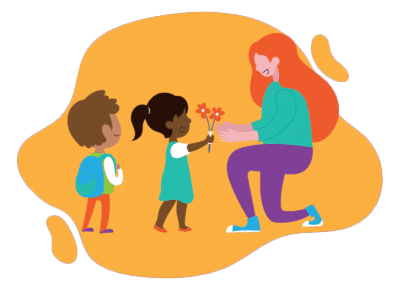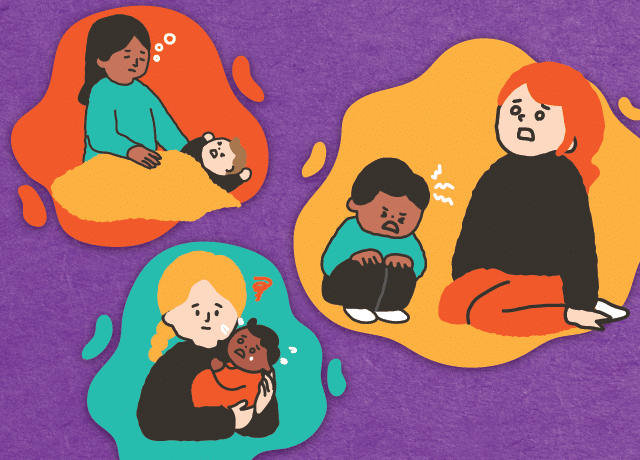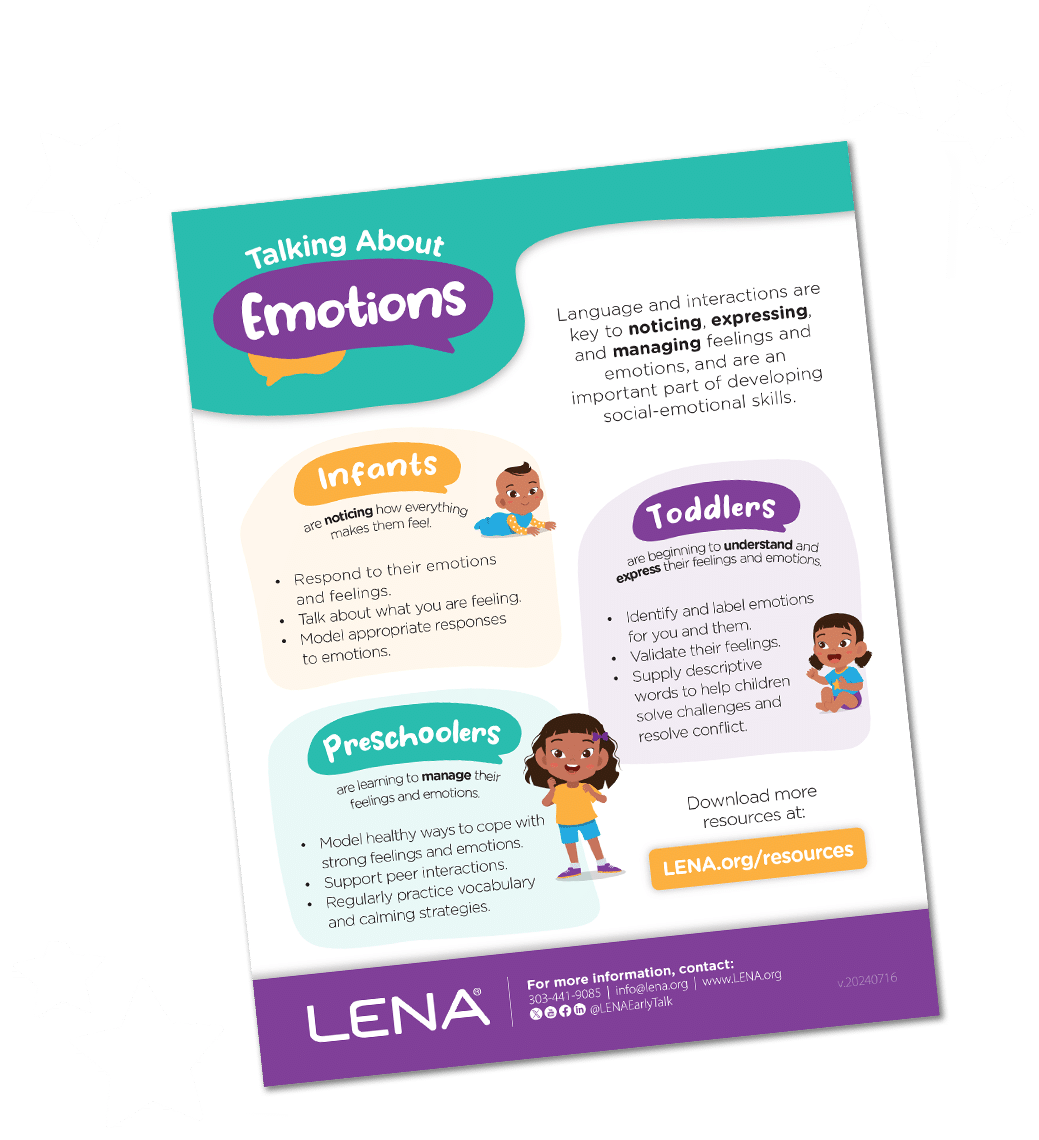Picture this: You’re leading a small-group art project when an aggressive tantrum breaks out from across the room. These challenging behaviors, all too common in early childhood education, can disrupt even the most well-planned lesson.
The National Center for Pyramid Model Innovations defines challenging behaviors as patterns that interfere with a child’s learning or social interactions. It is also more than that. As one expert in early care and education notes, “Challenging behavior is communication and it is used to communicate a message.”
Managing these behaviors is crucial. Understanding how to decode them, to figure out what the child is communicating, is crucial as well.
This overview explores the science behind challenging behaviors in children ages zero to five. It also looks at innovative approaches, such as those developed by LENA, to help early educators improve healthy social behaviors by improving healthy communication.
So, what exactly constitutes a challenging behavior? How do we distinguish it from typical development? Let’s dive in and explore these questions together.
"Challenging behavior is communication and it is used to communicate a message."
-Gail Joseph, University of Washington
Decoding Challenging Behaviors in Early Childhood Settings
Common Types of Challenging Behaviors

Early childhood classrooms are dynamic environments where children learn, play, and grow together. However, educators often encounter behaviors that can disrupt this positive atmosphere. At LENA, we commonly hear reports of challenging behaviors such as:
- Aggression: hitting, biting, or pushing peers.
- Defiance: refusing to follow instructions or routines.
- Tantrums: intense emotional outbursts.
- Withdrawal: avoiding social interactions or activities.
Mary Louise Hemmeter, a renowned researcher in early childhood education, found that teachers consider disruptive behaviors their greatest challenge. Her survey of over 500 educators revealed addressing challenging behavior as the top training need, highlighting its prevalence and impact in early childhood settings.
Developmentally Appropriate vs. Challenging Behaviors
Not all difficult behaviors warrant concern. Toddlers throwing occasional tantrums or preschoolers testing boundaries often represents normal developmental stages. However, behaviors become challenging when they:
- Persist despite consistent intervention.
- Interfere significantly with learning or peer relationships.
- Pose safety risks to the child or others.
- Occur with unusual frequency or intensity for the child’s age.
The National Association for the Education of Young Children (NAEYC) provides guidance on distinguishing between typical and challenging behaviors. They state, “[E]ducators need to be keen observers to understand what children are trying to communicate through their behavior.”
Impact on Learning and Social-Emotional Development
Challenging behaviors can cast long shadows over a child’s educational journey. Research highlights the prevalence of emotional and behavioral problems in young children, linking early social-emotional skills to later academic success. Early childhood educators know all too well that challenging behaviors can:
- Hinder academic progress by disrupting learning activities.
- Strain peer relationships, leading to social isolation.
- Negatively impact self-esteem and confidence.
- Increase stress levels for both the child and educator.
One startling statistic reveals that the expulsion rate in pre-K programs is three times higher than it is for K-12 students. This underscores the severe impact challenging behaviors can have on a child’s educational trajectory.
Furthermore, research has found that a child’s self-regulation skills at age four predicts their math and reading achievement from kindergarten to second grade. This demonstrates the long-term academic implications of early behavioral challenges.
To effectively address these behaviors, we must explore their underlying causes. For instance, how do early experiences shape a child’s ability to regulate emotions and actions? By diving into questions like this, we can develop more effective strategies to support children’s healthy development and learning, particularly through enhanced early talk and communication.
Early Childhood: Emotions and Challenging Behaviors
The Emotional Foundation of Early Childhood
Challenging behaviors in preschool children often signal deeper emotional and social developmental needs, sometimes stemming from adverse childhood experiences (ACEs). During these crucial years, children grapple with a complex array of skills:
- Decoding emotions (their own and others’).
- Forging friendships and navigating social dynamics.
- Developing resilience for difficult tasks.
- Balancing rule-following with individuality.
- Negotiating peer conflicts.
- Regulating emotional responses to stress.
These skills form the bedrock of a child’s future success. When children struggle in these areas, challenging behaviors may emerge as a form of communication, underscoring the importance of early talk and communication skills.
Unraveling the Roots of Challenging Behaviors
The Multifaceted Origins of Challenging Behavior
Challenging behaviors in early childhood stem from a complex interplay of factors:
- Physical discomfort (hunger, fatigue).
- Communication barriers.
- Sensory processing challenges.
- Unexpected transitions.
- Developing emotional regulation.
- Attention-seeking or control-asserting behaviors.
- Mirroring observed behaviors.
One way of thinking about how to decode challenging behaviors is the Antecedent-Behavior-Consequence (ABC) model, rooted in Applied Behavior Analysis (ABA):
- Antecedent: What happens immediately before the behavior?
- Behavior: What does the challenging behavior look like?
- Consequence: What happens immediately after the behavior?
Understanding the diverse origins of challenging behavior allows educators to approach them with empathy and insight, setting the stage for more effective communication in early childhood education settings.
Collaborative Strategies: Bridging Classrooms and Homes
Cultivating Connections, Crafting Supportive Spaces
Addressing challenging behaviors in early childhood education demands a comprehensive approach that seamlessly integrates classroom and home environments. Educators play a pivotal role in forging strong, positive relationships with children, creating a foundation of trust and security. This relationship-building is especially crucial when children exhibit challenging behaviors, as it provides an opportunity to strengthen connections and demonstrate unwavering support.
In tandem with relationship-building, structuring supportive environments proves essential. Effective classrooms often feature clear visual schedules, designated quiet spaces for emotional regulation, and consistent routines. These elements provide children with a sense of predictability and control, which can significantly reduce challenging behaviors. Families can mirror these strategies at home, ensuring a cohesive approach across settings and reinforcing the importance of structure and routine in managing behavior.
Nurturing Emotional Intelligence
Teaching social-emotional skills forms the cornerstone of preventing and addressing challenging behaviors. In classrooms, educators can incorporate structured lessons on identifying emotions, problem-solving, and self-regulation. They can also model positive communication themselves.
Extending these lessons into the home environment amplifies their impact. Families can reinforce classroom learning through daily interactions, modeling emotional regulation and positive problem-solving. This consistent approach across settings helps children internalize these crucial skills, leading to improved behavior and enhanced communication abilities. Rich, emotionally supportive interactions not only address challenging behaviors but also contribute to vocabulary development and overall language skills.
Uniting Educators and Families
The linchpin in addressing challenging behaviors lies in fostering robust educator-family partnerships. Regular, bidirectional communication forms the foundation of these relationships. This
By embracing these collaborative strategies, educators and families can create a united front in addressing challenging behaviors. However, implementing these approaches effectively requires ongoing professional development and support. How can we ensure that educators are equipped with the latest knowledge and tools to tackle these complex issues?
Empowering Educators: The Key to Transformative Change
Bridging the Knowledge Gap Around Challenging Behavior
Early childhood educators consistently identify addressing challenging behaviors as their most pressing training need. Specialized training equips educators with the tools to create positive learning environments and respond effectively to challenging behaviors.
Equipping the Educational Toolbox
Educators can access a wealth of resources to support their work with challenging behaviors. The Center on the Social and Emotional Foundations for Early Learning, an important forerunner of the Pyramid Model, offers comprehensive databases of research-based practices, behavior support plan templates, and visual supports for classroom use. These resources allow educators to stay current with best practices and implement effective strategies.
LENA Grow: Early Childhood Professional Development
LENA technology has transformed professional development in early childhood education. The technology is complex, but the takeaway is simple: Interacting more with children has amazing benefits. The more back-and-forth interactions an adult has with a child, the more responsive the relationship becomes, and the more the child can communicate with words instead of challenging behaviors.
The impact of the LENA Grow program might best be summed up by Larissa Fullilove, an instructional coach in Memphis, Tenn. Reflecting on her teachers’ participation in LENA Grow, she said, “Language builds relationships, and relationships build language.”
The LENA Grow program utilizes innovative “talk pedometer” technology to measure adult-child conversational turns throughout the day, providing objective data on language environments. This approach allows educators to:
- Analyze patterns in their interactions with children.
- Identify opportunities for increasing engagement.
- Set personalized goals for improving the classroom language environment.
“Language builds relationships, and relationships build language.”
-Rochelle Lewis, Porter-Leath
LENA Grow’s weekly reports and coaching sessions help educators interpret their data and develop enhancement strategies. There’s strong quantitative evidence of positive impact for children and teachers alike. There’s also a lot of anecdotal evidence directly from teachers. In fact, more than half of teachers who have participated in LENA Grow agree that the program helped reduce challenging behavior.
One LENA Grow teacher in Wisconsin, Judy Berdan, said, “Those behaviors that sometimes caused the chaos in the classroom really kind of went away.” Another teacher in Georgia, Shalinda Rountree, spoke about her struggles with one child’s emotional outbursts. With LENA Grow, she said, “I began to get on his level and give him the words he needed to resolve his conflicts.”
Indeed, something as simple as “getting down on their level” can turn into big changes around challenging behavior in early childhood education. That’s just one of LENA’s “14 Talking Tips,” a free downloadable resource to help teachers and caregivers increase their conversational turns with children.
When children have challenging behaviors, they’re trying to communicate something. What we’ve learned from teachers is that focusing on their own communication styles helps improve their relationship with the child. Aggression, defiance, and withdrawal give way to healthy ways of communicating feelings.
LENA’s unique contribution lies in its ability to quantify the less obvious aspects of the early childhood environment. This data empowers educators to make targeted improvements in their interactions with children, directly addressing challenging behaviors through enhanced communication.
Other Frameworks for Promoting Positive Behavior
LENA Grow is not the only solution to helping early educators address challenging behavior. By combining LENA Grow with other evidence-based frameworks, early childhood educators can create more responsive, language-rich environments. These innovative approaches offer powerful tools for nurturing positive behaviors, supporting early talk development, and setting the foundation for long-term social, emotional, and academic success.
The Pyramid Model: Building a Foundation for Success
The Pyramid Model for Promoting Social and Emotional Competence offers an evidence-based approach to addressing challenging behaviors in early childhood settings. This multi-tiered system provides educators with specific strategies for:
- Teaching rules and expectations
- Building relationships and classroom community
- Promoting engagement of all students
- Acknowledging positive behaviors
- Intentionally teaching social and emotional skills
Research demonstrates the Pyramid Model’s effectiveness, with preschool children showing greater improvement in behavior and social skills. Importantly, teachers maintained improved implementation even after coaching ended, indicating lasting positive change in classroom practices. LENA Grow supports the Pyramid Model, as detailed in this alignment.
Conscious Discipline: An Adult-First Approach
Scientific studies of brain function demonstrate that the process of learning is inseparable from its emotional and behavioral surroundings. When children tie academic skills to everyday feelings and behaviors, they are more likely to use the skills learned.
Conscious Discipline offers another powerful tool for early childhood educators. This methodology emphasizes adult self-regulation as a foundation for effective behavior management. Key components include:
- Brain State Model: Understanding how internal states influence behavior
- Seven Powers for Conscious Adults: Shifting perceptions to view discipline as teaching opportunities
- Creating the School Family: Building a culture of compassion and connection
- Seven Skills of Discipline: Problem-solving through social-emotional learning
Conscious Discipline aims to transform traditional — rewards-based and consequence-focused — approaches into teachable moments, focusing instead on reflection and responsibility. It is designed to help educators model the skills they want children to acquire, creating a positive classroom environment.
The Power of Positive Interactions
Adult-child relationships play a pivotal role in shaping behavior. Every interaction serves as a building block for a child’s social and emotional development. Positive, responsive caregiving can foster resilience and self-regulation skills, while inconsistent interactions may reinforce challenging behaviors.
The quality of these interactions matters as much as the quantity. Rich, meaningful exchanges that validate a child’s emotions and experiences can significantly impact their behavioral outcomes. LENA’s innovative technology has quantified this impact. By measuring conversational turns between adults and children, researchers have drawn direct links between positive verbal engagement and accelerated social-emotional skill-building.

Understanding that “behavior is communication” is crucial in addressing challenging behaviors in early childhood settings. Programs like LENA Grow play a vital role in this approach by helping educators build responsive relationships and create language-rich environments. By focusing on enhancing communication skills, we can effectively address the root causes of challenging behaviors, fostering positive development and setting the stage for lifelong success.
Ready to take the next step in supporting children’s emotional development? Download our “Talking About Emotions” resource for practical strategies you can implement today. And to discover more about how you can mitigate challenging behavior in the early childhood education setting, check out the replay of our most recent free webinar, “Understanding Challenging Behavior in Early Childhood.”
Language and interactions are key to noticing, expressing, and managing feelings and emotions, and are an important part of developing social-emotional skills.








One Comment on “Understanding Challenging Behavior in Early Childhood Education: A Focus on Communication Skills”
Wonderful guidance for early educators.